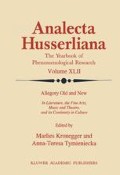Abstract
The mythical allegory of Madana, the god of love, has been continually appearing in the realm of our creativity and culture since ancient times. The source of Madana can be traced back not in the Vedas but in the Puranas (the Hindu mythologies), especially in the Kalika Purana and also in the Brahmavaivarta purana, Siva Purana and Matsya Purana. The aim of this paper is to sketch some selected depictions of Madana as found in Kalidasa’s and Rabindranath’s works, with a view to reviewing these in our present context.
Access this chapter
Tax calculation will be finalised at checkout
Purchases are for personal use only
Preview
Unable to display preview. Download preview PDF.
Notes
See Bangiya Sahitya Parishad, Bharatakosha, Part V (Calcutta, 1973), pp. 277–8. Bangla Visvakosha, ed. N. Basu (New Delhi: B. R. Publishing Corporation, 1988), Part 14, pp. 24–26.
Also consult the Sanskrit Amarakosha and different dictionaries (Bengali to English).
All the names of Madana have come to Bengali from Sanskrit. Most are compound words revealing mythological allusions and allegories.
Rabindranath Tagore, Kalpana (Imagination) (1900), Rabindra-Rachanavali (collection of Tagore’s works, henceforth to be written as RR) Vol. I, Birth-Centenary Edition (Govt. of West Bengal, 1961), pp. 701–3.
R. Tagore, “Madan-bhasmer Par”, op. cit., p. 702.
R. Tagore, Chitrangada (Calcutta: Visva-Bharati Publishing Department, 1966).
R. Tagore, Nrityanatya Chitrangada (Calcutta: Visva-Bharati Publishing Department, edition 1358 B.S. 1951).
RR 6, pp. 1031–1090.
1916; edition with musical notation 1355 B.S. (1948). Thereafter various editions have appeared from the Visva-Bharati Publishing Department.
RR 6, pp. 441–488. 1329 B.S. (1923). Visva-Bharati editions started from 1337 B.S. onwards. RR 5, pp. 585–601.
RR 5, pp. 619–663.
Author information
Authors and Affiliations
Editor information
Editors and Affiliations
Rights and permissions
Copyright information
© 1994 Springer Science+Business Media Dordrecht
About this chapter
Cite this chapter
Ray, S. (1994). Madana (The Mythical Love-God) in Kalidasa and Tagore. In: Kronegger, M., Tymieniecka, AT. (eds) Allegory Old and New. Analecta Husserliana, vol 42. Springer, Dordrecht. https://doi.org/10.1007/978-94-011-1946-7_22
Download citation
DOI: https://doi.org/10.1007/978-94-011-1946-7_22
Publisher Name: Springer, Dordrecht
Print ISBN: 978-94-011-7649-1
Online ISBN: 978-94-011-1946-7
eBook Packages: Springer Book Archive

